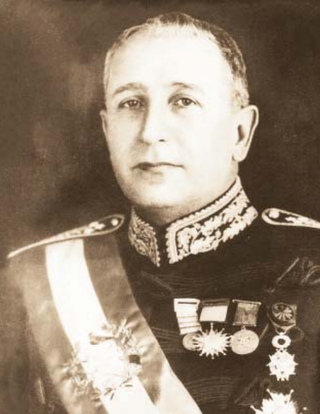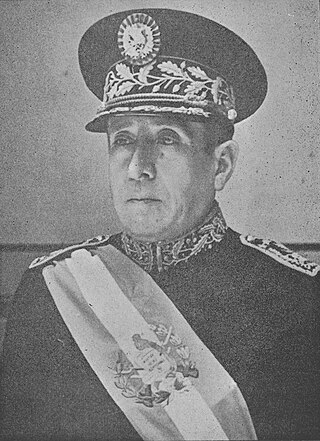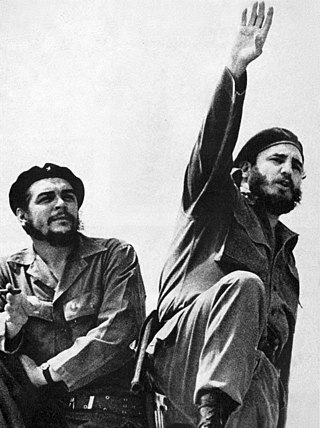History
In Guatemala's first democratic elections in 1944, it joined a broad coalition of revolutionary parties to support the election bid of Juan José Arévalo, but subsequently distanced itself from his government. In November 1945, it merged with the National Renovation Party to form the Revolutionary Action Party (PAR), but split from it eighteen months later. This split was partially the result of ideological differences, and partially the result of manipulations by Arévalo, who preferred to deal with a fractured opposition. During the period that it was a part of the PAR, as well as in alliance with the PRN, it enjoyed a majority in the Guatemalan Congress for the entire presidential term of Juan José Arévalo, and until 1949, it was the largest of the parties involved in the Guatemalan Revolution.
The FPL was also the most conservative of the revolutionary parties, until 1949. In that year the party split between those who supported the presidential candidacy of Francisco Javier Arana, and those who opposed him. Arana's supporters left to form the "FPL Ortodoxo," or the Orthodox FPL. In the 1950 election, the remainder of the FPL formally endorsed Víctor Manuel Giordani, but some party members defected to support Jorge García Granados, another moderate civilian, while still others supported Jacobo Árbenz, the defence minister and the administration's candidate. This infighting furthered the decline of the FPL.

Juan Jacobo Árbenz Guzmán was a Guatemalan military officer and politician who served as the 25th President of Guatemala. He was Minister of National Defense from 1944 to 1950, before he became the second democratically elected President of Guatemala, from 1951 to 1954. He was a major figure in the ten-year Guatemalan Revolution, which represented some of the few years of representative democracy in Guatemalan history. The landmark program of agrarian reform Árbenz enacted as president was very influential across Latin America.

Jorge Ubico Castañeda, nicknamed Number Five or also Central America's Napoleon, was a Guatemalan dictator. A general in the Guatemalan military, he was elected to the presidency in 1931, in an election where he was the only candidate. He continued his predecessors' policies of giving massive concessions to the United Fruit Company and wealthy landowners, as well as supporting their harsh labor practices. Ubico has been described as "one of the most oppressive tyrants Guatemala has ever known" who compared himself to Adolf Hitler. He was removed by a pro-democracy uprising in 1944, which led to the ten-year Guatemalan Revolution.

Carlos Castillo Armas was a Guatemalan military officer and politician who was the 28th president of Guatemala, serving from 1954 to 1957 after taking power in a coup d'état. A member of the right-wing National Liberation Movement (MLN) party, his authoritarian government was closely allied with the United States.

Juan José Arévalo Bermejo was a Guatemalan statesman and professor of philosophy who became Guatemala's first democratically elected president in 1945. He was elected following a popular uprising against the United States-backed dictator Jorge Ubico that began the Guatemalan Revolution. He remained in office until 1951, surviving 25 coup attempts. He did not contest the election of 1951, instead choosing to hand over power to Jacobo Árbenz. As president, he enacted several social reform policies, including an increase in the minimum wage and a series of literacy programs. He also oversaw the drafting of a new constitution in 1945. He is the father of President-elect of Guatemala Bernardo Arévalo.

The 1954 Guatemalan coup d'état was the result of a CIA covert operation code-named PBSuccess. It deposed the democratically elected Guatemalan President Jacobo Árbenz and ended the Guatemalan Revolution of 1944–1954. It installed the military dictatorship of Carlos Castillo Armas, the first in a series of U.S.-backed authoritarian rulers in Guatemala.

General José Miguel Ramón Ydígoras Fuentes was a Guatemalan military officer and politician who served as president of Guatemala from 1958 to March 1963. He was also the main challenger to Jacobo Árbenz during the 1950 presidential election. Ydígoras previously served as the governor of the province of San Marcos.

Francisco Javier Arana Castro was a Guatemalan military leader and one of the three members of the revolutionary junta that ruled Guatemala from 20 October 1944 to 15 March 1945 during the early part of the Guatemalan Revolution. A major in the Guatemalan army under the dictator Jorge Ubico, he allied with a progressive faction of the army to topple Ubico's successor Federico Ponce Vaides. He led the three-man junta that oversaw the transition to a democratic government, although he was personally reluctant to allow the elected President Juan José Arévalo to take office in 1945. He served as the Chief of the Armed Forces in the new government until 1949. On 18 July 1949 he was killed in a shootout with supporters of the Arévalo government after he threatened to launch a coup.

Juan Federico Ponce Vaides was the acting President of Guatemala from 4 July 1944 to 20 October 1944. He was overthrown by a popular uprising on 20 October 1944 that began the Guatemalan Revolution.
Operation PBFortune, also known as Operation Fortune, was a covert United States operation to overthrow the democratically elected Guatemalan President Jacobo Árbenz in 1952. The operation was authorized by U.S. President Harry Truman and planned by the Central Intelligence Agency. The United Fruit Company had lobbied intensively for the overthrow because land reform initiated by Árbenz threatened its economic interests. The US also feared that the government of Árbenz was being influenced by communists.

The Guatemalan Labour Party was a communist party in Guatemala. It existed from 1949 to 1998. It gained prominence during the government of Jacobo Arbenz. It was one of the main forces of opposition to the various regimes that followed Arbenz's overthrow, and later became a constituent of the URNG guerrilla coalition during the later phase of the country's Civil War.
Amatitlán is a town, with a population of 98,176, and a municipality in the Guatemala department of Guatemala.

The Caribbean Legion was a group of progressive Latin American leaders, exiles, and revolutionaries in the 1940s, with the aim of overthrowing dictatorships across Central America and replacing them with democratic governments.
The Party of the Guatemalan Revolution was formed in June 1952 during the Guatemalan Revolution to unite the non-Communist parties which were supporting the administration of Jacobo Árbenz. These included the Popular Liberation Front, the National Renovation Party, the Revolutionary Action Party, and the Socialist Party. The Communist Guatemalan Party of Labour (PGT) was opposed to the formation of the PRG, fearing that it would undermine their influence in the government. The PAR and the PRN later withdrew. Although the PRG continued in existence until the overthrow of the President Árbenz, it had failed to achieve its original purpose of opposing Communist efforts to gain a predominant voice in the Árbenz government. It was disbanded after the coup d'état of 1954.
The Revolutionary Action Party was a leftist political party in Guatemala during the ten-year Guatemalan Revolution. Formed in 1945, the party went through a series of mergers and fractures before dissolving in 1954 after the United States-backed coup d'état.
The National Renovation Party was a reformist and progressive political party in Guatemala that was supportive of the government of Jacobo Arbenz. The PRN was founded by a group of the young revolutionaries on 1 July 1944, following the overthrow of dictator Jorge Ubico and the beginning of the Guatemalan Revolution. Its founders included Juan José Orozco Posadas, and Mario Efraín Nájera Farfán. The PRN was known as a “teachers' party”, in contrast to the Popular Liberation Front (FPL), which was seen as a "students' party”. During this period the PRN and the FPL were the largest of the revolutionary parties.
Parliamentary elections were held in Guatemala between 26 and 28 November 1948 in order to elect half the seats in Congress. The National Renovation Party-Revolutionary Action Party alliance won the most seats, but the Popular Liberation Front remained the largest party.
Presidential elections were held in Guatemala between 17 and 19 December 1944. The October Revolution had overthrown Jorge Ubico, the American-backed dictator, after which a junta composed of Francisco Javier Arana, Jacobo Árbenz and Jorge Toriello took power, and quickly announced presidential elections, as well as elections for a constitutional assembly. The subsequent elections were broadly considered free and fair, although only literate men were given the vote. Unlike in similar historical situations, none of the junta members stood for election. The front-runner was the philosophically conservative University professor Juan José Arévalo, of the National Renovation Party. His closest challenger was Adrián Recinos, whose campaign included a number of individuals identified with the Ubico regime. The ballots were tallied on 19 December and Arévalo won in a landslide with 86.25% of the vote, receiving more than four times as many votes as the other candidates combined. The Constitutional Assembly elections took place on 28–30 December, with the United Front of Arevalist Parties winning 50 of the 65 seats.
The period in the history of Guatemala between the coups against Jorge Ubico in 1944 and Jacobo Árbenz in 1954 is known locally as the Revolution. It has also been called the Ten Years of Spring, highlighting the peak years of representative democracy in Guatemala from 1930 until the end of the civil war in 1996. It saw the implementation of social, political, and especially agrarian reforms that were influential across Latin America.
José Manuel Fortuny Arana was an important communist leader in Latin America. He became well known for his friendship with Guatemalan President Jacobo Árbenz, and was one of the main advisers in his government, which lasted from 1951–54. Árbenz was overthrown by a coup engineered by the United States in 1954, an event which drove Fortuny into exile, along with many of his comrades.
Colonel Carlos Aldana Sandoval was a Guatemalan military officer who was a significant figure in the popular uprising against the government of Federico Ponce Vaides in October 1944. At the time of the uprising, Sandoval held the rank of Major in the Guardia de Honor, a powerful unit of the military. Sandoval, one of the leaders of the plot among the military, was among those who felt that the plot should remain among the military: however, Árbenz insisted on including civilians in the process. Sandoval was able to persuade Francisco Javier Arana to join the coup in its final stages, but did not participate in the actual coup. Historian Piero Gleijeses stated that Sandoval was among the plotters who lost his nerve at the last minute.









